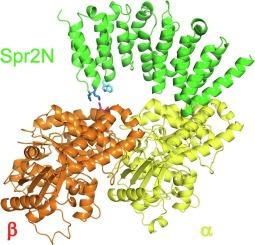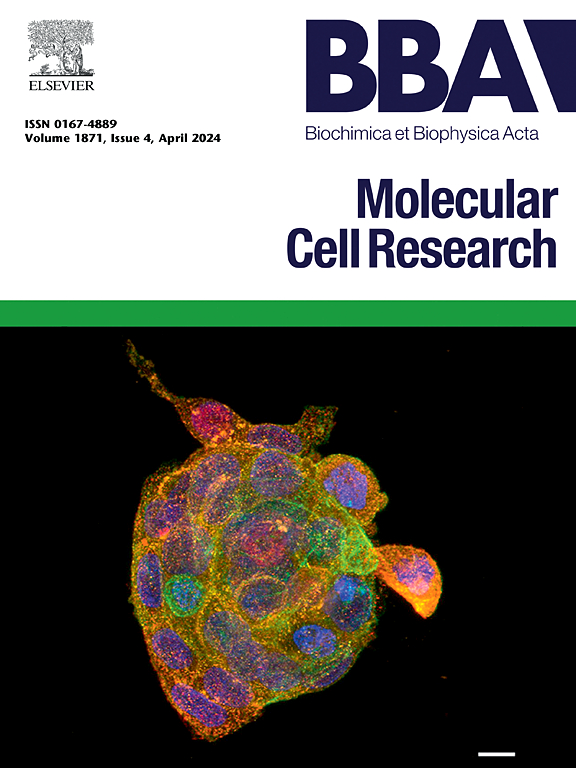Structural analysis of microtubule binding by minus-end targeting protein Spiral2
IF 4.6
2区 生物学
Q1 BIOCHEMISTRY & MOLECULAR BIOLOGY
Biochimica et biophysica acta. Molecular cell research
Pub Date : 2024-10-04
DOI:10.1016/j.bbamcr.2024.119858
引用次数: 0
Abstract
Microtubules (MTs) are dynamic cytoskeletal polymers that play a critical role in determining cell polarity and shape. In plant cells, acentrosomal MTs are localized on the cell surface and are referred to as cortical MTs. Cortical MTs nucleate in the cell cortex and detach from nucleation sites. The released MT filaments perform treadmilling, with the plus-ends of MTs polymerizing and the minus-ends depolymerizing. Minus-end targeting proteins, -TIPs, include Spiral2, which regulates the minus-end dynamics of acentrosomal MTs. Spiral2 accumulates autonomously at MT minus-ends and inhibits filament shrinkage, but the mechanism by which Spiral2 specifically recognizes minus-ends of MTs remains unknown. Here we describe the crystal structure of Spiral2's N-terminal MT-binding domain. The structural properties of this domain resemble those of the HEAT repeat structure of the tumor overexpressed gene (TOG) domain, but the number of HEAT repeats is different and the conformation is highly arched. Gel filtration and co-sedimentation analyses demonstrate that the domain binds preferentially to MT filaments rather than the tubulin dimer, and that the tubulin-binding mode of Spiral2 via the basic surface is similar to that of the TOG domain. We constructed an in silico model of the Spiral2-tubulin complex to identify residues that potentially recognize tubulin. Mutational analysis revealed that the key residues inferred in the model are involved in microtubule recognition, and provide insight into the mechanism by which end-targeting proteins stabilize MT ends.

负端靶向蛋白 Spiral2 与微管结合的结构分析
微管(MT)是一种动态细胞骨架聚合物,在决定细胞极性和形状方面起着至关重要的作用。在植物细胞中,顶体 MT 定位于细胞表面,被称为皮层 MT。皮层 MT 在细胞皮层成核,并从成核点分离。释放出来的MT丝进行踩踏运动,MT的正端聚合,负端解聚。负端靶向蛋白(-TIPs)包括螺旋2(Spiral2),它能调节顶体MT的负端动态。Spiral2 在 MT 负端自主聚集并抑制纤维收缩,但 Spiral2 特异性识别 MT 负端的机制仍不清楚。在这里,我们描述了 Spiral2 N 端 MT 结合结构域的晶体结构。该结构域的结构特性与肿瘤过表达基因(TOG)结构域的 HEAT 重复结构相似,但 HEAT 重复的数量不同,而且构象呈高度弧形。凝胶过滤和共沉淀分析表明,该结构域优先与 MT 细丝结合,而不是与微管蛋白二聚体结合,而且 Spiral2 通过基本表面与微管蛋白结合的模式与 TOG 结构域类似。我们构建了一个Spiral2-微管蛋白复合物的硅学模型,以确定可能识别微管蛋白的残基。突变分析表明,模型中推断出的关键残基参与了微管识别,并为末端靶向蛋白稳定MT末端的机制提供了启示。
本文章由计算机程序翻译,如有差异,请以英文原文为准。
求助全文
约1分钟内获得全文
求助全文
来源期刊
CiteScore
10.00
自引率
2.00%
发文量
151
审稿时长
44 days
期刊介绍:
BBA Molecular Cell Research focuses on understanding the mechanisms of cellular processes at the molecular level. These include aspects of cellular signaling, signal transduction, cell cycle, apoptosis, intracellular trafficking, secretory and endocytic pathways, biogenesis of cell organelles, cytoskeletal structures, cellular interactions, cell/tissue differentiation and cellular enzymology. Also included are studies at the interface between Cell Biology and Biophysics which apply for example novel imaging methods for characterizing cellular processes.

 求助内容:
求助内容: 应助结果提醒方式:
应助结果提醒方式:


